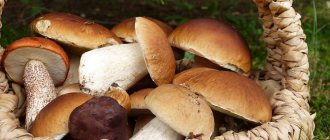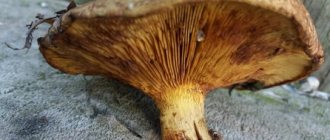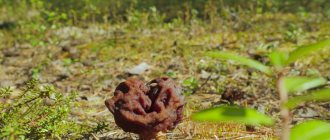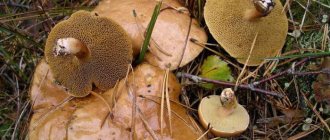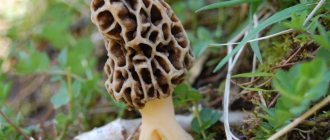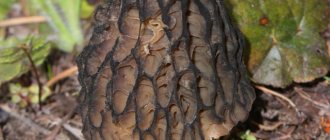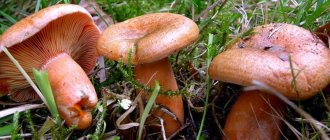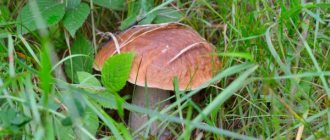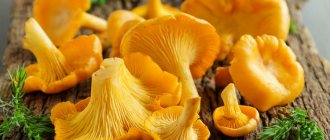Fried with potatoes
Required:
- Svinushki – 200 gr.
- Potatoes – 300 gr.
- Onions – 2 pcs., medium size.
- Garlic – 3 cloves, medium size.
- Butter – 50 gr.
- Vegetable oil.
- Cheese – 100 gr., hard varieties.
- Black pepper, salt and herbs - to taste.
Cooking:
- Fry the fruit bodies in a frying pan in vegetable oil, along with the onion, cut into cubes, for 10 minutes.
- Add sliced potatoes to the pan and simmer over low heat until tender, adding a little water if necessary and stirring.
- Sprinkle the finished dish with grated cheese, season with butter and herbs. If desired, you can add sour cream.
About the edibility of pig mushrooms
In order for eating pigs to cause as little harm to the body as possible, you need to know how to properly prepare them for consumption. The following processing method is recommended:
- Mushrooms should be peeled immediately after picking;
- peeled mushrooms should be soaked for a day in water with the addition of a small amount of salt and citric acid. This will help remove radioisotopes and heavy metal salts. The water needs to be changed several times;
- Rinse the soaked mushrooms well and boil in salted water for 5 minutes, discard the water. Then boil them in clean water two more times for half an hour and wash again;
- cooled mushrooms can be fried, stewed, salted, marinated, added to salads, fillings for pies and dumplings and other dishes.
Pigs are characterized by active absorption of various chemical compounds, radioisotopes and heavy metals, including lead
Marinated pigs
According to reviews from mushroom lovers, salted and pickled pigs are a very tasty preparation.
Ingredients:
- pork (boiled) – 2 kg;
- water – 1 l;
- vinegar - 2 tbsp. l;
- salt – 1 tbsp. l;
- sugar – 1 tbsp. l;
- bay leaf – 5 pcs;
- pepper (allspice) – 15 pcs;
- garlic - 3 cloves.
How to cook:
Boil water, add salt, sugar, spices and mushrooms cut into small pieces, pour in vinegar. Cook for about 20 minutes;
- Wash and sterilize containers with a volume of 1 liter;
- Place the mushrooms in containers, pour marinade over them and add 2 tbsp to each. l olive oil;
- Sterilize jars with mushrooms for 20 minutes and can be closed with tin lids;
- Cooled pieces should be sent to the cellar for storage.
In order for eating pigs to cause as little harm to the body as possible, you need to know how to properly prepare them for consumption.
Salted pork in oil
Ingredients:
- pork (boiled) – 1 kg;
- olive oil – 200 ml;
- salt – 100 g;
- garlic – 3 cloves;
- bay leaf – 5 pcs;
- pepper (allspice) – 15 pcs.
Cooking method:
- Cut the mushrooms into thick strips;
- Heat vegetable oil in a deep frying pan;
- Fry the mushrooms over low heat for an hour;
- Sterilize the jars, place the prepared mushrooms in them, pour hot vegetable oil on top and close with plastic lids;
- It is recommended to store cooled preparations in the refrigerator.
Processing method
If someone considers himself the owner of an “iron stomach” that is capable of digesting even nails, you can try to collect and cook these insidious gifts of nature.
Before you begin culinary manipulations with pigs, you need to soak them in water for 6-7 hours . Then drain the water and repeat soaking a couple more times. After this, boil the mushrooms for 7-9 minutes (for 1 kg of mushrooms you will need 1 liter of water and 1 teaspoon of table salt). Drain the water, add new, cold water and boil the mushrooms for another 40 minutes. Now they can be cooled and placed in the refrigerator, where they can be stored for up to three days pending their intended use (pickling, frying, pickling).
Poisonous mushrooms: description of toadstool
Poisonous varieties of pigs
“You need to know your enemy by sight” - this folk wisdom also applies to poisonous mushrooms, which include some varieties of pig mushrooms. And in order not to become a victim of your own ignorance, returning home with baskets full of poisonous pigs, you need to undergo an educational program.
Alder
This small fungus with a tapering stalk and an inverted ocher cap grows almost throughout the entire Eurasian continent. The main features of the mushroom are dense yellow flesh, dry scaly skin of the cap, lack of odor and hymenophore plates that extend into the stalk. This variety is considered one of the most poisonous among the members of the family, so it should definitely be avoided.
Ear-shaped
A specific external feature of this mushroom is the complete disproportion and asymmetry of its fruiting body. In their youth, these uniformly beige-colored mushrooms have numerous hairs, making their surface velvety, but over time these hairs become less and less, as a result of which the pig becomes completely bald, losing its former charm.
The subtle smell of pine needles, emitted by a fungus that tends to parasitize tree trunks, also attracts attention. That is why, when encountering this parasite, it is recommended to destroy it in order to protect coniferous trees from their destructive effects.
But it is quite difficult to get poisoned by these mushrooms, but not because they are not poisonous, but because they taste like hard rubber.
Ammonia
Another poisonous representative of the family, emitting a specific smell that begins to appear in European forests no earlier than autumn. The main feature of this fleshy species is its rather high stalk, often growing 10 cm from the ground, as well as large elongated chocolate-colored spores.
Sporebearing
This golden brown pig is no less poisonous than all the previous ones. An inhabitant of coniferous forests and broad-leaved groves, it has snow-white or slightly creamy flesh with a pleasant mealy aroma, beginning to appear in early summer and stopping to bear fruit only in late autumn. The mushroom is quite easy to confuse with edible mushrooms.
What pigs look like
Mushrooms have two varieties: “thick” and “thin” pig mushrooms, which differ slightly in color and shape. Mushrooms are generally considered to be poisonous and toxic mushrooms due to the fact that they provoke autoimmune effects in the human body and also contain radioactive substances that do not break down when boiled. Nevertheless, many people admit a significant reduction in tumors, a positive effect on the body that pig mushrooms have. Their description is given below.
Is pork good for you?
You can meet a pig in the forest on the edges and sunny hills. Also, its gangs can be found along the edges of potato fields and in forest clearings. Other names for these mushrooms are pigsties, chushkars and even cowsheds. If you come across pigs along the road, it is better not to collect them. They perfectly absorb all harmful exhaust gases and toxins, which is unlikely to have a beneficial effect on the human body.
Not every housewife knows how to cook salted and pickled pigs. It is believed that the best container for pickling is a wooden barrel. But it is unlikely to be found in a modern kitchen, so it is better to take any ceramic container. Pre-boiled and washed pigs are laid in layers, sprinkled with table salt. If you want the mushrooms to be crispy, add cherry and horseradish leaves. Also added for flavor are dill stems, allspice and a few cloves of garlic.
Next, the pigs are covered with clean gauze, a press is placed on top and put in a cool place for salting. You can eat salted pigs after 40 days. Experienced cooks recommend storing these mushrooms at a temperature of at least 5 degrees, otherwise there is a risk that the pigs will freeze, causing their taste to be greatly affected. If the temperature is higher, the brine may turn sour and the mushrooms will have to be thrown away.
During the salting process, it is also important to periodically add boiled water, since the brine tends to evaporate.
Vinushki, according to modern mycologists, cannot be collected. One of them is poisonous (thin pig), the other is edible (thick pig) only after boiling for three hours. Mushroom pickers usually collect thin pig, which is much more common than thick pig. Unfortunately, it was she who ended up on the list of poisonous mushrooms. The insidiousness of this mushroom lies in the fact that the symptoms of poisoning do not appear immediately. The poison must first accumulate in the human body. Moreover, the amount of poison is different for each person. Some people have been collecting and eating mushrooms for years, while others get seriously poisoned by repeated consumption of mushrooms. That's why these mushrooms remained above suspicion for so long.
Description of the fat pig.
When poisoned with pork belly, liver function is disrupted, kidneys stop functioning, and other important organs are seriously affected. Sometimes it all ends in resuscitation. Doctors recognize several degrees of pig poisoning: a mild degree (lasts from 2 to 6 days) is characterized by the appearance of signs of gastroenteritis. Severe and extremely severe degrees seriously affect the liver and kidneys. Cardiovascular failure develops, and a moderate breakdown of red blood cells occurs. The coherence of speech is disrupted. Breathing becomes difficult. Limbs go numb. It is strictly forbidden to cook pigs (thin and thick) in “field” conditions: fry them over a fire and make “kebabs” out of them. You shouldn’t overeat yourself with these mushrooms, so as not to speed up the process of poison accumulation.
Types and their descriptions with photos
Mushrooms consist of eight species of mushrooms. Some of them are not very common:
- Ear-shaped. It looks like an oyster mushroom and grows on the trunks of coniferous trees, attached to them with a leg or a shoot from the cap.
The color is olive, yellow or brown, the plates are light. The diameter of the cap is in the range of 2-8 cm. Growth time is late summer and autumn. - Scaly. A rare species with a cap up to 8 cm and a stalk 4-8 cm. The cap is yellowish with large gray scales. The identification mark is the proximity of alder, because only with it does it form mycorrhiza. Fruits in the second half of summer.
Most often there are two types of cowshed: thick, which is still eaten, and thin, which is dangerous to human health and life. It is imperative to distinguish them. Photos can additionally help with this; they are even recommended to take them with you into the forest and compare them there.
Conditionally edible
Fat pig belongs to a group that is characterized by very low taste and has no value as a source of useful components. In foreign literature it appears as inedible or with unstudied properties.
The distinctive features of the fat pig are the slow darkening of the cut, a short and thick velvety leg of a dark brown or black color, which has been compared to a cigar. The cap can reach 25 cm in diameter, velvety to the touch, brown or pistachio, with spots.
The cap can reach 25 cm in diameter, velvety to the touch, brown or pistachio, with spots.
You may be interested in:
How to prepare delicious pickled mushrooms at home We offer you a universal recipe for preparing wild mushrooms. They are marinated for 2 hours, and if you…Read more…
Dangerous
The thin pig has a fleshy cap with curled edges and a funnel in the center. Olive color, darkens with age.
The size of the cap is usually in the range of 12-15 cm; it is very rare to find a 20-centimeter one. She herself is fleshy and thick. At a young age it is light and dome-shaped, over time it changes shape to flat and even slightly curved towards the center, and the color darkens.
The range of colors is from light gray to rich olive. The edges of the cap are wavy, the surface is rough and fluffy, although if there is a lot of moisture around, it becomes glossy, slippery and sticky.
Cowshed
The leg is also small and smooth; it can reach a maximum of 9 cm in length and only 2 cm in width. The color is the same as the hat. A characteristic feature of the barn is that the flesh inside is light yellow, but when broken or cut it quickly darkens to brown.
Period and rules for collecting edible pigs
If mushroom pickers, despite not very flattering characteristics, still collect a barn, then you need to adhere to some rules:
- You should go on a “quiet hunt” far deep into the forest, moving as far away as possible from highways and industrial buildings of factories - this will reduce the chances of collecting harmful chemicals for dinner;
Collection of pigs - take only young fruiting bodies, old ones accumulate more of these compounds over time;
- do not eat large portions, mushrooms are, in principle, quite heavy food, they should play the role of a savory addition in the plate, and not the main dish or side dish;
- prepare dunki, scrupulously following all the rules: start cooking as early as possible, wash thoroughly, cook for a long time in several stages, draining the broth each time, do not store the finished dish for more than a few hours.
The time for collecting pork is the second half of summer and autumn.
You may be interested in:
How to properly and tasty pickle boletus and boletus mushrooms (18 photos)? The most common and most common in our country are tubular (spongy) mushrooms. Representatives of spongiforms –…Read more…
Differences between thick mushrooms and thin mushrooms and other poisonous mushrooms
The two most common pigs differ quite noticeably from each other in the rate of darkening of the flesh when broken and the leg, namely its color and thickness. It is convenient to compare this from the photos posted above. Barnyard mushrooms have no obvious resemblance to other poisonous mushrooms.
Recipes and features of cooking fat pigs
The Svinushkov family belongs to the poisonous and conditionally edible ones. Therefore, for an inexperienced mushroom picker who has not studied all the nuances and features of pigs from photos and descriptions, it is better to avoid these mushrooms. Svinushka has not only several varieties, but also other names: dunka, pig, cowshed, pig's ear, solokha. Mushrooms are small, regardless of type.
By structure they are lamellar; usually the plates are light brown or yellow. The color of the top of the cap is from light beige to brown. The leg, depending on the type, can be thin and tall or thick and short, or completely absent
That’s why it’s so important to determine the identity of the pig by its appearance.
You may be interested in:
Eating
Whether a mushroom is edible or not depends primarily on the species, but the place of growth also matters: for example, poisonous neighbors are quite capable of transferring their properties to an edible mushroom growing nearby. Thin pork should not be eaten under any circumstances, thick pork can only be eaten after prolonged cooking, although it has very low taste, so real gourmets ignore it.
Due to the fact that pigs have long been considered completely edible and are now sometimes eaten, many recipes have been preserved.
To clean the mushroom as much as possible from harmful substances absorbed during growth, it is soaked in salt water for three days. Then boil for 2-3 hours, draining the broth after five minutes of cooking after each boil. The second option is soaking for a day, then cooking alternately in salt and vinegar water for half an hour.
The taste of barnyard becomes interesting after frying. To do this, you need to take 700 g of boiled mushrooms, 2 onions, 2 tbsp. l. sour cream, oil for frying and spices to taste: salt, pepper, a couple of bay leaves.
Fried pigs
Before frying, you will have to cook the pork for a long time: you need to spend several hours on this (the methods are described above). And only then the cut fruit bodies are fried for 10 minutes in oil with spices and 5 with sour cream.
Preparation for the winter
Before closing a jar of pigs for the winter, they must be soaked. The recipe is for 1 kg of raw mushrooms (young, medium-sized ones):
- 500 ml vinegar;
- 3 cups olive oil;
- spices: 2-3 medium-sized bay leaves, black pepper, salt, garlic.
Harvesting mushrooms
Answers to questions from mushroom pickers
The main question for mushroom pickers regarding pigs is whether they are edible or not. The answer is clear - they are dangerous to eat, regardless of the method of preparation.
Fans of salted or pickled forest mushrooms should give preference to the edible counterparts of sow mushrooms - saffron milk caps, volnushki or honey mushrooms.
The harmfulness of pigs has been proven by modern scientists. To avoid irreversible negative health effects, you should avoid consuming these mushrooms.
You should not believe recipes that tell you that it is enough to clean, wash and salt the pigs to eliminate toxins. This is deadly, so it is better to give preference to collecting sponge mushrooms (boletus mushrooms, boletus mushrooms, etc.), which are guaranteed to be suitable for consumption.
Can it be eaten?
Any type of pig can accumulate radiation
Until recently, the thick mushroom (felt) was considered an absolutely non-poisonous mushroom. It was this that was actively consumed as food. Since 1984, after numerous studies, scientists have officially classified the mushroom as inedible. The pulp contains the poison muscarine. It is not destroyed during heat treatment: even cooking for 3–4 hours cannot remove toxins from the pulp.
Ingestion of a large dose of muscarine causes acute poisoning with characteristic symptoms:
- increased salivation;
- weakness and dizziness;
- nausea and vomiting;
- pressure drop;
- heart rhythm disturbance;
- loose stools and sharp abdominal pain.
The second substance that threatens health is the antigen protein. It triggers the process of red blood cell gluing, resulting in instant blood clotting. Blood clots form in large vessels of the brain and heart, which can be fatal. When entering the body in small doses, the antigen protein accumulates, causing anemia and other blood diseases. The result of exposure can be myocardial infarction, stroke, pulmonary vein thrombosis.
Pigs collected near highways, plants and factories, and nuclear power plants are especially dangerous. The fungus actively absorbs radioactive isotopes of copper and cesium, salts of heavy metals and other harmful substances. Regular consumption of pigs can have serious consequences for the body.
However, our ancestors ate pigs from time immemorial, and it is generally accepted that poisoning is caused only by improper preparation. Acute disorders are associated with the consumption of poisonous varieties.
Felted pork from the Tapinella genus can be eaten after soaking and repeated boiling. To avoid poisoning, you need to distinguish it from the thin one - the double of the conditionally edible mushroom. This species is clearly classified as poisonous and is included in the list of inedible in the Russian Federation.
Main differences:
- The fat pig has a short leg that gradually turns into a cap. The surface of the mushroom is soft to the touch and dry.
- The false one becomes sticky after the rain. The stem is thin, cylindrical, lighter than the cap or matches it in tone.
Useful properties and restrictions on use
Despite all the above disadvantages, the pig also has useful properties. Here are some of them:
- it contains the substance atromentin, which has an antibiotic effect and is used in antitumor drugs;
- in Eastern medicine it is used as a muscle relaxant (to relax muscles) and an anti-convulsant;
- contains the poison muscarine, which is important in research medicine; hopes are pinned on it in the field of oncology, but at this stage development is still underway;
Thin pig - serves as a blue dye for natural fiber;
- with a calorie content of 30 kcal per 100 g there is almost 4 g of protein and 16 g of carbohydrates, that is, suitable for people on a low-calorie diet;
- contains vitamins A, C, PP, group B, macro- and microelements that help with cardiovascular diseases and high cholesterol.
There are also contraindications limiting the consumption of pigs. Forbidden:
- pregnant and lactating women;
- children;
- people with chronic diseases with seasonal exacerbations;
- for digestive diseases;
- for problems with kidney function;
- for blood diseases.
You may be interested in:
Incredibly tasty cabbage solyanka with mushrooms for the winter Cabbage solyanka with mushrooms is a tasty and original preparation for the winter. Its recipe is very simple - chop...Read more...
Description of the fat pig
It is always important to weigh the benefits and harms before deciding to include barnyard in your diet.
First aid for poisoning
Mushroom poisoning is considered one of the most dangerous. If any suspicious symptoms appear after eating thin pigs, you must immediately call an ambulance or take the victim to the nearest hospital as quickly as possible. Before a poisoned person falls into the hands of specialists, gastric lavage will be useful. It is necessary to drink warm boiled water, and then induce vomiting until the contents that come out are clean, without food residues. You can consume activated carbon in large quantities. However, only doctors can provide full qualified assistance, so self-medication is unacceptable, and you should go to the hospital in any case, even if the indicated first aid measures alleviated the symptoms.
Chronic poisoning is dangerous because there is no antidote for them - you can only minimize the consequences using plasmapheresis and hemodialysis procedures, and relieve an allergic reaction through the use of antihistamines. The thin pig is a dangerous inhabitant of forest areas.
Taking advantage of its similarity to some other edible mushrooms, as well as the fact that some mushroom lovers count on the fact that “maybe it will blow over,” it penetrates the baskets of mushroom pickers, and then, in finished form, onto dinner tables. The use of this mushroom is akin to Russian roulette - poisoning can occur at any time, because it is impossible to predict what amount of toxins and poisons will be fatal for the body.
Poisoning with pig mushrooms.
Mushroom harm
All pigs are definitely not valuable mushrooms. Harm to health can be caused by eating even conditionally edible fat pig, if you eat it often and in large portions.
Poisonous properties
Pig contains substances that affect the functioning of a living organism - lectins. They do not die during heat treatment. As they pass through the digestive system, they enter the blood cells and disperse throughout the body, initially causing an allergic reaction. But the antibodies that come to defense do not attack the lectins themselves, but the cells in which they are located. That is, the action of the organism is directed against the organism itself.
And the next insidious step of poisons is kidney damage, the appearance of renal failure. In addition to the composition of the mushroom itself, the danger is posed by the ability of pig mushroom to accumulate heavy metals from the soil and radioactive compounds; sometimes during research they found quantities that were hundreds of times higher than normal.
Pig poisoning
Poisoning can occur in the first hours or spread over time. It depends on the dose of poison, the frequency of its use, the state of the whole organism, and immunity. There is a cumulative effect at work here. At first, dizziness, changes in consciousness, nausea, vomiting, abdominal pain, and diarrhea may occur. The skin becomes pale or, on the contrary, jaundice develops; shock or breathing problems may occur.
Important!
You need to act immediately at the first suspicion of poisoning, because kidney failure is the final part, which can result in death. This was confirmed by a German mycologist with his personal tragic example in 1944. These mushrooms are especially dangerous for children of any age.
First aid
Sometimes the symptoms of pig poisoning do not appear immediately, but even after several days. In this case, it is not always possible to guess that the cause of poor health is in them. But in case of mushroom poisoning, self-medication or delay is unacceptable. The first thing to do is go to the hospital immediately.
First aid for mushroom poisoning
There they will do all the necessary laboratory tests and other manipulations (gastric and intestinal lavage, administration of an antihistamine and more complex resuscitation procedures), the patient will be under constant supervision of doctors monitoring basic vital signs. Laboratory tests may show erythropenia, abnormalities in bilirubin and hemoglobin.
Unfortunately, today there is no antidote for this type of substance, and treatment is aimed only at reducing symptoms. That is why early contact with doctors is key.
Effect on the body, consequences of eating thin pork
Until 1993, the mushroom was considered conditionally edible; it was collected and fried, boiled, and salted. After 1993, it was classified as poisonous, but many mushroom pickers, due to habit and their own carelessness, still continue to collect and prepare this toxic “bomb.” The mechanism of its action is partly similar to the effect of radiation exposure: negative consequences most often do not appear immediately, but have a cumulative effect, that is, poisoning by these mushrooms can be chronic. This is probably why people continue to eat pig's ear, naively believing that if alarming symptoms do not appear immediately, then everything is fine. This misconception is very dangerous for several reasons:
- the mushroom contains hemolysin, hemoglutin, lectin, muscarine - toxic substances, while the last two of them are not destroyed by heat treatment;
- toxic and harmful substances that are in the mushroom are not eliminated from the body during life;
- in people suffering from kidney failure, dishes made from thin pigs can cause severe poisoning with a fatal outcome.
Due to the poisonous content of muscarine, pig's ear is compared to fly agarics. The difference is that if you eat fly agaric, symptoms of poisoning and death will occur within 24 hours, while the results of eating pigs will appear much later.
Thin pork causes a strong allergic reaction in the body. As a result of consuming the mushroom, irreversible changes occur in the blood: antibodies to one’s own red blood cells begin to be produced. Red blood cells are destroyed, anemia and kidney failure begin. In the future, a heart attack, stroke or thrombosis may occur.
Thin pigs have strong absorbing properties: they, like a sponge, absorb heavy metal salts, radioactive isotopes of cesium and copper from the environment. Collected near roads, factories, and nuclear power plants, these mushrooms become even more harmful and dangerous. For chronic poisoning, periodic consumption of small amounts of pork ear, for example, in salted form, is sufficient. In the period from 2-3 months to several years, the first health problems may appear.
The above does not mean that the mushroom cannot cause acute poisoning immediately after eating. Children, the elderly, and those who suffer from diseases of the gastrointestinal tract and kidneys are at risk. For them, eating a mushroom dish 30-40 minutes after eating can cause the following symptoms:
- acute pain in the peritoneum;
- diarrhea;
- nausea and vomiting;
- jaundice;
- pallor;
- increased salivation;
- sweating;
- weakness, deterioration of coordination;
- hypotension.
If a large amount of toxin enters the body, then swelling of the brain and lung tissue occurs, resulting in death.
The benefits and harms of pigs
For a long time, pig mushrooms were considered conditionally edible mushrooms. They could be eaten salted or after prolonged heat treatment.
Modern scientists have proven that the pulp of these mushrooms contains dangerous toxins. They can accumulate in the body and cause severe poisoning and kidney failure. But pigs can also be useful.
Scientists have discovered that they contain the natural phenolic compound atromenthin. It can cause the death of leukemic cells, so it is used in the fight against blood and bone marrow cancer.
Edibility Proponents' Arguments
Svinushka is well known to experienced mushroom pickers and is very popular. The first fruits appear long before other mushrooms and delight with a bountiful harvest until late autumn. Fans of the spring forest delicacy consider them very tasty. The question of whether it is possible to eat pig mushrooms will only bring a smile to fans, because this mushroom is popularly called the edible pig mushroom. You just need to boil it longer, from 20 to 40 minutes, after which you can cook as usual.
Proponents of edibility are not embarrassed by rumors of poisoning with this product. Inexperienced foragers can become poisoned if they place an inedible mushroom mixed with edible ones in a basket, which is quite enough to cause a food reaction. In addition, pig mushrooms are very similar in appearance to other poisonous mushrooms. You should know well what pigs look like so as not to confuse them, and then you can safely prepare delicious dishes from them and diversify your table.
The strongest argument in favor of edibility is that throughout our lives our grandparents loved to cook soup, roasts, and pickles from these mushrooms. The main thing is to know how to cook. Absolutely any product can be poisonous if not prepared correctly.
